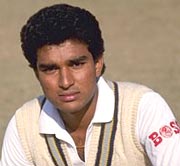Home > Cricket > Report
Indians have to show more energy: Manjrekar
Ashish Magotra |
October 14, 2003 11:16 IST
For a batsman of his class and skill, Sanjay Manjrekar should have ended up with an average much higher than 37.14 in Tests. But then statistics do not always tell the full story.
For a certain period of time, Manjrekar was regarded as one of the best technicians in the game. His highest Test score of 218 against Pakistan in 1989-90 placed him in the hallowed list of a handful of Indians who have scored double hundreds.
 Just a couple of days ago, Australian opener Matthew Hayden scored his record-breaking 380, the highest individual Test score, making Indian fans wonder when one of our batsmen would ever score a triple hundred.
Just a couple of days ago, Australian opener Matthew Hayden scored his record-breaking 380, the highest individual Test score, making Indian fans wonder when one of our batsmen would ever score a triple hundred.
"Very difficult to put a finger on the reason why we have not got a triple centurion," says Manjrekar. "In fact, when Gavaskar held the highest Test score by an Indian, 236 not out, I thought it was pretty embarrassing. But then V V S Laxman got that amazing 281 and we could at least say that someone had got close.
"What is really worrying for India is that no one has got past 236 after Laxman. This team certainly has the talent for someone to score triple hundreds."
But it is also interesting to note that of all the triple centuries scored in Tests so far, not one has been scored in India. Maybe the weather conditions are too harsh to bat for long periods. Or maybe it's the pitches.
"No, I don't think that is the case," says Manjrekar. "Sanath Jayasuriya got a triple century in Sri Lanka batting in very, very hot conditions. Most triple hundreds are got at home where the batsmen are at ease with the conditions. Perhaps the match situations have not been conducive."
The most recent Indian to score a double century is Rahul Dravid. His chanceless 222 put India in the driver's seat for the first Test against New Zealand at Ahemdabad. More importantly, this innings revealed a new, aggressive edge to Dravid's batting.
"Definitely," agrees Manjrekar. "There has been a change in the way Rahul bats. He is more aggressive and that comes from him becoming a better one-day cricketer. He now has the ability to just tap the ball into a gap and take a quick single.
"One of the most important developments has been the fact that he is not bothered too much now about being technically correct. Earlier, at times, he wanted to play every shot in a copybook format. [Now] he wants to keep the scoreboard ticking. And he seems to be maximising it [his run-scoring] to the best of his ability."
Ever since he began keeping wickets for the team in Limited Overs Internationals, Dravid's fitness levels have also improved. Moreover, while the stint behind the stumps may not have been too enjoyable for Dravid, the team has revelled in the balance he has lent it.
 Manjrekar too believes Dravid must continue to keep wickets. "But I don't think his fitness has improved as a result of his wicket-keeping," he argues. "It is the result of the changes in the management. The fitness of the entire team has improved."
Manjrekar too believes Dravid must continue to keep wickets. "But I don't think his fitness has improved as a result of his wicket-keeping," he argues. "It is the result of the changes in the management. The fitness of the entire team has improved."
Another striking feature of the Ahmedabad Test was the Indian spinners' inability to make the decisive breakthrough on the final day once Craig McMillan and Nathan Astle got together and put their heads down to play for a draw. Was that on account of the dead pitch, as captain Sourav Ganguly said, or do Anil Kumble and Harbhajan Singh not form the ideal spin combination for India?
"I think Kumble did a very god job," says Manjrekar. "He was under pressure and on a pitch that was not offering him a lot of support he performed admirably. He was under pressure and he came out fighting. His first innings was not too impressive, but he bowled very well in the second innings. So for the moment, Kumble and Harbhajan are the bowlers for India.
"For [the tour of] Australia though, we might require another spinner like Murali Karthik or Sairaj Bahutule."
As for the second Test, which begins in Mohali on Thursday, Manjrekar is not too optimistic. "If we have a good flat pitch, I think the second Test will also be a draw," he says. "We have seen that the Kiwis are a very well-knit unit and they are fighters.
"The Indians have to show more energy. They were just not eager enough to force a result here. Perhaps it is the long gap from international cricket, but this was not the team we had seen over the last few years."